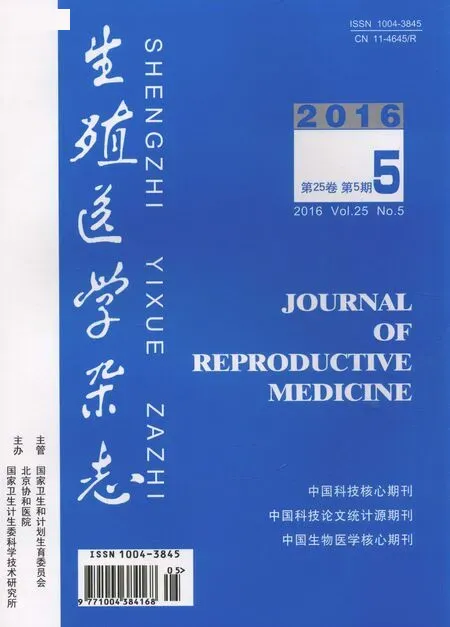干细胞向生殖细胞分化的研究进展
张琴静,覃莲菊,崔毓桂,刘嘉茵
(南京医科大学第一附属医院生殖医学科,南京 210029)
干细胞向生殖细胞分化的研究进展
张琴静,覃莲菊,崔毓桂,刘嘉茵*
(南京医科大学第一附属医院生殖医学科,南京210029)
【摘要】干细胞(SCs)具有在体外分化为生殖细胞的潜能,为研究生殖细胞(GCs)早期发育提供了良好的模型,并将为干细胞移植修复生殖功能提供细胞资源。本文综述了胚胎干细胞/诱导多能干细胞(ESCs/iPSCs)、新生儿附属物来源干细胞(NDSCs)以及成体干细胞(ASCs)向生殖细胞分化所取得的研究进展,同时总结了各类干细胞向生殖细胞分化时所遇到的障碍及所面临的挑战,为干细胞在生殖医学领域的应用提供理论依据。
【关键词】生殖细胞;胚胎干细胞;成体干细胞;新生儿来源干细胞;分化
(J Reprod Med 2016,25(5):478-481)
干细胞(SCs)是一类具有分化为各种类型细胞潜能的特殊细胞。干细胞可在体外诱导条件下分化为早期生殖细胞、卵母细胞样细胞以及精子样细胞[1],因此可作为研究生殖细胞早期发育的可靠模型,该模型的研究不但有利于了解生殖细胞发育调控机制,而且可为临床生殖医学和组织再生医学带来福音。根据来源,干细胞可分为胚胎干细胞(ESCs)、新生儿附属物干细胞(NDSCs)、成体间充质干细胞(ASCs)、组织干细胞(TSCs)、诱导多能干细胞(iPSCs)等。本文总结了不同来源干细胞向生殖细胞分化的研究现状,同时也探讨了不同类型干细胞分化为成熟生殖细胞所面临的挑战,最后展望了各类干细胞在生殖医学临床治疗上的前景。
一、ESCs/iPSCs的生殖细胞分化潜能
ESCs来源于囊胚内细胞团,是一种全能干细胞,具有分化为三胚层来源所有细胞类型的潜能。iPSCs通过将转录因子OCT3/4、SOX2、KLF4以及C-MYC转染成体细胞重编程而获得,其形态特征、分化潜能均与ESCs类似。目前,ESCs/iPSCs已成为再生医学研究领域不可或缺的细胞资源,同时也在生殖医学研究中发挥了重要作用。
2003年,报道首次证实小鼠ESCs(mESCs)能在体外诱导分化为卵母细胞样细胞(OLCs)[2],这些配子样细胞甚至可以产生后代[3-4]。然而,体外分化只能获得早期配子样细胞且效率非常低,原因很可能是无法完成正常的减数分裂[1]。后来,Yu等[5]的研究发现DAZL基因是调控生殖细胞成熟的一个关键基因,Wang等[6]发现GASZ基因能够显著促进原始生殖细胞的生成,且GASZ与DAZL相互作用。最近,Hayashi等[7]利用阶梯式培养方法从mESCs及iPSCs获得了卵母细胞,且经体外受精获得了健康后代。该方法分化率高,且避免了过多体外诱导步骤可能导致的遗传突变。
因伦理限制,人类ESCs/iPSCs向生殖细胞分化的研究进展相对缓慢,且多集中于对诱导分化条件的探索[8]。最近,Wongtrakoongate等[9]证实Stella可促进hESCs分化为生殖细胞及内胚层细胞系;而Duggal等[10]报道Actin A可提高hESCs在体外分化为生殖细胞的效率,且这种促进作用与TGFb/Activin信号通路的激活有关。Gkountela等[11]的研究则显示,hESCs分化为原始生殖细胞的过程涉及了基因表达和表观遗传学的改变。最新的分化体系可使得ESCs/iPSCs向原始生殖细胞样细胞(PGCLCs)分化的效率大于20%,同时也揭示了SOX17/BLIMP1可能是PGCLCs分化中的关键因子[12]。
二、NDSCs的生殖细胞分化潜能
新生儿附属物指正常分娩新生儿所带的脐带、胎盘、胎膜和羊水等。目前研究表明,脐带间充质干细胞(UC-MSCs)、羊膜上皮细胞(AECs)、羊水干细胞(AFSCs)都具有分化为生殖细胞的潜能。
1. UC-MSCs的生殖细胞分化潜能:UC-MSCs分离自脐带,具有间充质干细胞(MSCs)的形态学特征及特性,在体外诱导培养条件下可向三胚层分化,包括向生殖细胞分化。Huang等[13]在体外用维甲酸(RA)、雄激素和睾丸细胞生长培养基诱导hUC-MSCs分化,在mRNA和蛋白水平分别检测到生殖细胞特异标志物;随后的研究证实骨形态形成蛋白(BMP4)可诱导hUC-MSCs向男性生殖细胞样细胞分化[14]。2012年,Qiu等[15]证明了高浓度的羊水(FF)可以诱导UC-MSCs分化为原始卵泡阶段的卵母细胞样细胞。Qiu等[16]把Filga转入hUC-MSCs中,最终获得了突破原始卵泡阶段的卵母细胞样细胞。
2. AECs的生殖细胞分化潜能:AECs分离自羊膜,与生殖细胞具有相同的胚层起源,因此天然具有向生殖细胞分化的潜能[17]。Evron等[18]证明在血清培养基中生长的hAECs可表达生殖细胞的特异标志物并可分化为卵母细胞样细胞。Wang等[19]发现hAECs能分化为卵巢颗粒细胞并且能恢复化疗小鼠受损的卵巢功能。
3. AFSCs的生殖细胞分化潜能:2008年,Stefanidis等[20]发现一部分AFSCs表达生殖细胞标志物DAZL,同时也表达c-Kit、SSEA-4和OCT4。Lai等[21]研究发现,AFSCs可被诱导分化为高表达生殖细胞标志物的细胞,同时AFSCs移植后可分化为颗粒细胞,改善化疗引起的不孕小鼠的卵巢功能。2014年,Yu等[22]从羊水中分离获得CD117+/CD44+细胞,这些细胞经诱导培养,可表达卵母细胞特异基因并进一步分化为具有孤雌生殖能力的卵母细胞样细胞。最新文献报道显示,AFSCs不但可以防止卵泡闭锁,也可恢复化疗引起的卵巢早衰小鼠的卵巢功能[23]。
三、ASCs的生殖细胞分化潜能
成体干细胞(ASCs)广泛存在于哺乳动物的组织、脏器,分化能力相对有限,但仍具有向生殖细胞分化的潜能[1]。
1. 骨髓干细胞(BMSCs)的生殖细胞分化潜能:BMSCs起源于中胚层和内胚层的早期发育阶段,是干细胞家族的重要成员。RA可体外诱导BMSCs分化为不同分化时期生殖细胞样细胞[24],而BMP4可诱导SSEA-1+BMSCs分化为原始生殖细胞样细胞[25]。BMSCs来源的生殖细胞被阻滞在发育的早期阶段,要获得更为成熟的生殖细胞需要添加额外的未知细胞因子[24]。有学者提出,骨髓干细胞可能是卵母细胞的起源[26],此后BMSCs被广泛应用于受损卵巢的修复治疗实验。2012年,Santiqute等[27]将BMSCs注入卵巢损伤模型小鼠体内,发现BMSCs不能分化为卵母细胞,但可通过影响卵巢生理环境而改善小鼠的生殖能力。最新的研究表明,BMSCs可减少化疗小鼠的细胞凋亡和DNA损伤[28]。
2. 脂肪间充质干细胞(ADSCs)的生殖细胞分化潜能:ADSCs来自脂肪组织,体外可被诱导分化为多种细胞。Cakici等[29]建立输精管损伤小鼠模型,然后将GFP+ADSCs注入一侧输精管,发现注射ADSCs的输精管形态正常,输精管内发现GFP+/VASA+以及GFP+/SCP1+精子,并且这些精子授精后能产生后代;而对侧未注射ADSCs的输精管则萎缩。这一研究证明,ADSCs在合适的体内环境下可以分化为生殖细胞。最近,Hosseinzadeh等[30]用RA体外诱导ADSCs分化,获得了表达生殖细胞标志基因DAZL、MVH、Stra8及SCP3的生殖细胞样细胞,但表达量较BMSCs来源的生殖细胞样细胞低。
其它来源的成体干细胞,如皮肤干细胞(SDSCs)、胰腺干细胞(PSCs)均已被证明可在体外条件下分化为生殖细胞样细胞[1]。
四、存在的问题
迄今为止,已在体外自hESCs/iPSCs诱导形成人类PGCLCs[3-4,12],相信不久即可体外获得成熟的生殖细胞,这将对临床生殖医学产生重大影响——人类有可能彻底解决因配子质量导致的生殖障碍疾病。然而,hESCs在生殖临床上的应用尚存在伦理限制,同时其来源有限也是临床应用的一大阻碍,因此,目前hESCs仅局限于生殖医学研究领域。与hESCs相比,hiPSCs涉及的伦理问题少、来源广泛、免疫排斥弱,而且结合基因修饰技术可更正遗传缺陷,最有可能用于彻底解决人类的生殖问题,因此临床应用前景非常广阔。不过,现有培养技术尚不能把iPSCs分化为成熟生殖细胞,因此须努力探索更有效的分化体系;此外,重编程获得hiPSCs的过程中导入了外源基因或暴露于小分子化学物,有可能导致细胞的遗传和表观遗传发生了很难检测到的微小变异,而这种变异有可能对hiPSCs来源生殖细胞产生的个体造成严重后果:如胎儿畸形及发育不良,成人高发慢性病、肿瘤等,故hiPSCs在用于临床研究前须进行谨慎评估。
胎儿附属物来源的多能干细胞可能在人类生殖障碍的临床治疗上有所作为。然而迄今为止,从该类干细胞仅能诱导获得早期生殖细胞样细胞,无法获得成熟生殖细胞。可能的原因有:(1)目前的诱导分化方案尚不够成熟;(2)该类细胞无法分化为成熟生殖细胞。如果原因为前者,则须克服一系列的技术障碍,然而即使最终获得了成熟生殖细胞,依然存在医学伦理问题即分化的生殖细胞源自异体,因此需谨慎对待。如果原因为后者,则该类细胞无法作为配子来源细胞。幸运的是,动物实验显示,AFSCs、AECs移植后均可分化为卵母细胞的支持细胞——颗粒细胞,从而帮助修复化疗引起的卵巢功能损伤。基于此,胎儿附属物干细胞虽然不能直接分化为成熟生殖细胞彻底解决配子缺乏问题,但移植后可改善生殖功能,因此在生殖障碍辅助治疗以及抗衰老领域具有光明前景。值得注意的是,虽然羊水来源的AFSCs较易获得,但羊水中所含细胞种类繁多,且大部分为已分化的成体细胞,而用于研究的具体细胞类型也很难明确,因此AFSCs在临床治疗前景上不如 AECs。另外,机制研究显示,间充质干细胞可通过分泌相关细胞因子修复受损器官功能[31-32];我们最近的研究也表明,新生儿附属物干细胞可能通过分泌的细胞因子改善卵巢微环境进而改善生殖(未发表数据),提示将来也许只需注射干细胞培养液即可修复生殖功能。
成体干细胞在生殖临床上面临的挑战、机遇与新生儿附属物干细胞相似,但价值较新生儿附属物干细胞低,原因如下:(1)成体干细胞更“老”,其多能性不如新生儿附属物干细胞,推测其辅助治疗效果也不如新生儿附属物干细胞;(2)成体干细胞发育、生长的时间更长,存在遗传及表观遗传变异的几率更高,因此安全性也不如新生儿附属物干细胞。成体干细胞的优势是可自体移植,然而,个体的年龄及体质会严重影响成体干细胞的质量[33],而质量差的干细胞治疗潜力非常有限。也就是说,并非任何个体都适于进行自体干细胞治疗。
综上所述,hESCs在生殖细胞分化机制研究方面具有无可比拟的优势;而iPSCs则可能在攻克生殖细胞成熟的技术难题后彻底解决人类因配子质量低下所导致的生殖问题;新生儿附属物干细胞目前虽不能分化为成熟的生殖细胞,但可立即作为辅助治疗手段进入生殖功能改善临床试验;成体干细胞临床应用前景与新生儿附属物干细胞类似,但效果不如后者。
【参考文献】
[1]Sun YC,Cheng SF,Sun R,et al. Reconstitution of gametogenesis in vitro:meiosis is the biggest obstacle[J]. J Genet Genomics,2014,41:87-95.
[2]Hübner K,Fuhrmann G,Christenson LK,et al. Derivation of oocytes from mouse embryonic stem cells[J]. Science,2003,300:1251-1256.
[3]Hayashi K,Ohta H,Kurimoto K,et al. Reconstitution of the mouse germ cell specification pathway in culture by pluripotent stem cells[J]. Cell,2011,146:519-532.
[4]Hayashi K,Ogushi S,Kurimoto K,et al. Offspring from oocytes derived from in vitro primordial germ cell-like cells in mice[J]. Science,2012,338:971-975.
[5]Yu Z,Ji P,Cao J,et al. Dazl promotes germ cell differentiation from embryonic stem cells[J]. J Mol Cell Biol,2009,1:93-103.
[6]Wang Q,Liu X,Tang N,et al. GASZ promotes germ cell derivation from embryonic stem cells[J]. Stem Cell Res,2013,11:845-860.
[7]Hayashi K,Saitou M. Generation of eggs from mouse embryonic stem cells and induced pluripotent stem cells[J]. Nat Protoc,2013,8:1513-1524.
[8]Imamura M,Hikabe O,Lin ZY,et al. Generation of germ cells in vitro in the era of induced pluripotent stem cells[J]. Mol Reprod Dev,2014,81:2-19.
[9]Wongtrakoongate P,Jones M,Gokhalep J,et al. STELLA facilitates differentiation of germ cell and endodermal lineages of human embryonic stem cells[J/OL]. PLoS One,2013,8:e56893.
[10]Duggal G,Heindryckx B,Warrier S,et al. Influence of activin A supplementation during human embryonic stem cell derivation on germ cell differentiation potential[J]. Stem Cells Dev,2013,22:3141-3155.
[11]Gkountela S,Li Z,Vincent JJ,et al. The ontogeny of cKIT+human primordial germ cells proves to be a resource for human germ line reprogramming,imprint erasure and in vitro differentiation[J]. Nat Cell Biol,2013,15:113-122.
[12]Fong CY,Chak LL,Biswas A,et al. Human Wharton’s jelly stem cells have unique transcriptome profiles compared to human embryonic stem cells and other mesenchymal stem cells[J]. Stem Cell Rev,2011,7:1-16.
[13]Huang P,Lin LM,Wu XY,et al. Differentiation of human umbilical cord Wharton’s jelly-derived mesenchymal stem cells into germ-Like cells in vitro[J]. J Cell Biochem,2010,109:747-754.
[14]Li N,Pan S,Zhu H,et al. BMP4 promotes SSEA-1(+) hUC-MSC differentiation into male germ-like cells in vitro[J]. Cell Prolif,2014,47:299-309.
[15]Qiu P,Bai Y,Liu C,et al. A dose-dependent function of follicular fluid on the proliferation and differentiation of umbilical cord mesenchymal stem cells (MSCs) of goat[J]. Histochem Cell Biol,2012,138:593-603.
[16]Qiu P,Bai Y,Pan S,et al. Gender depended potentiality of differentiation of human umbilical cord mesenchymal stem cells into oocyte-Like cells in vitro[J]. Cell Biochem Funct,2013,31:365-373.
[17]Miki T. Amnion-derived stem cells:in quest of clinical applications[J]. Stem Cell Res Ther,2011,2:25.
[18]Evron A,Goldman S,Shalev E. Human amniotic epithelial cells differentiate into cells expressing germ cell specific markers when cultured in medium containing serum substitute supplement[J]. Reprod Biol Endocrinol,2012,10:108.
[19]Wang F,Wang L,Yao X,et al. Human amniotic epithelial cells can differentiate into granulosa cells and restore folliculogenesis in a mouse model of chemotherapy-induced premature ovarian failure[J]. Stem Cell Res Ther,2013,4:124.
[20]Stefanidis K,Loutradis D,Koumbi L,et al. Deleted in Azoospermia-Like (DAZL) gene-expressing cells in human amniotic fluid:a new source for germ cells research?[J]. Fertil Steril,2008,90:798-804.
[21]Lai D,Wang F,Chen Y,et al. Human amniotic fluid stem cells have a potential to recover ovarian function in mice with chemotherapy-induced sterility[J]. BMC Dev Biol,2013,13:34.
[22]Yu X,Wang N,Qiang R,et al. Human amniotic fluid stem cells possess the potential to differentiate into primordial follicle oocytes in vitro[J]. Biol Reprod,2014,90:73.
[23]Xiao GY,Liu IH,Cheng CC,et al. Amniotic fluid stem cells prevent follicle atresia and rescue fertility of mice with premature ovarian failure induced by chemotherapy[J/OL]. PLoS One,2014,9:e106538.
[24]Nayemia K,Lee JH,Drusenheimer N,et al. Derivation of male cells from bone marrow stem cells[J]. Lab Invest,2006,86:654-663.
[25]Shirazi R,Zarnani AH,Soleimani M,et al. BMP4 can generate primordial germ cells from bone-marrow-derived pluripotent stem cells[J]. Cell Biol Int,2012,36:1185-1193.
[26]Johnson J,Bagley J,Skaznik-Wikiel M,et al. Oocyte generation in adult mammalian ovaries by putative germ cells in bone marrow and peripheral blood[J]. Cell,2005,122:303-315.
[27]Santiquet N,Vallières L,Pothier F,et al. Transplanted bone marrow cells do not provide new oocytes but rescue fertility in female mice following treatment with chemotherapeutic agents[J]. Cell Reprogram,2012,14:123-129.
[28]Kilic S,Pinarli F,Ozogul C,et al. Protection from cyclophosphamide-induced ovarian damage with bone marrow-derived mesenchymal stem cells during puberty[J]. Gynecol Endocrinol,2014,30:135-140.
[29]Cakici C,Buyrukcu B,Duruksu G,et al. Recovery of fertility in azoospermia rates after injection of adipose-tissue-derived mesenchymal stem cells:the sperm generation[J]. Biomed Res Int,2013,2013:529589.
[30]Hosseinzadeh Shirzeily M,Pasbakhsh P,Amidi F,et al. Comparison of differentiation potential of male mouse adipose tissue and bone marrow derived-mesenchymal stem cells into germ cells[J]. Iran J Reprod Med,2013,11:965-976.
[31]Peng Y,Xuan M,Zou J,et al. Freeze-dried rat bone marrow mesenchymal stem cells paracrine factors:a simplified novel material for shin wound therapy[J]. Tissue Eng Part A,2015,21:1036-1046.
[32]Ma J,Liu N,Yi B,et al. Transplanted hUCB-MSCs migrated to the damaged area by SDF-1/CXCR4 signaling to promote functional recovery after traumatic brain injury in rats[J]. Neurol Res,2015,37:50-56.
[33]Baker N,Boyette LB,Tuan RS,et al. Characterization of bone marrow-derived mesenchymal stem cells in aging[J]. Bone,2015,70:37-47.
[编辑:侯丽]
Research of stem cells differentiation to germ cells
ZHANG Qin-jing,QIN Lian-ju,CUI Yu-gui,LIU Jia-yin*
State Key Laboratory of Reproductive Medicine,Center of Clinical Reproductive Medicine,The First Affiliated Hospital,Nanjing Medical University,Nanjing210029
【Abstract】Stem cells (SCs) are promised to differentiate to germ cells,providing a valuable in vitro model for investigating early development of germ cells,and it will become the cell resource for stem cell transplantation therapy. The paper reviews the advances in the study on embryonic stem cells/induced pluripotent stem cells (ESCs/iPSCs),neonatal-derived stem cells (NDSCs) and adult stem cells (ASCs) differentiating to germ cells,meanwhile summarizes the obstacles encountered in the differentiation of stem cells to germ cells. It will provide a theoretical basis for the application of stem cells in the field of reproductive medicine.
【Key words】Germ cells (GCs);Embryonic stem cells (ESCs);Adult stem cells (ASCs);Neonatal-derived stem cells (NDSCs);Differentiation
DOI:10.3969/j.issn.1004-3845.2016.05.019
【收稿日期】2015-06-26;【修回日期】2015-08-21
【基金项目】公益性卫生行业专项(201402004,201302013);江苏省科技厅项目(BL2012009,BM2013058)
【作者简介】张琴静,女,江苏昆山人,硕士,妇产科专业.(*通讯作者)

